Wyoming is a state known for its rugged wilderness, stunning natural beauty, and abundant wildlife. It’s also known as a great place for foragers to break out their field guides and work on identifying wild mushrooms, edible berries, and other native plants. When it comes to the wild berries of Wyoming, there’s a lot to see.
Do Wild Berries Grow In Wyoming?
Foragers in Wyoming have access to huckleberries, wild raspberries, thimbleberries, serviceberries, baneberry, elderberries, chokecherry, gooseberries, woods’ rose, wild currants, buffaloberry, and more.
Of course, while there are a number of edible berry species in Wyoming, there are also poisonous berries and ones that are toxic in specific circumstances. For example, you should never eat raw elderberries, but they can be consumed when they’re cooked properly. Chokecherries are edible, but you should never swallow the seeds.
New berry pickers have a lot of rules to learn when it comes to properly identifying and eating native plants in Wyoming. For some people, it’s not worth the effort, and they may be best sticking to what they can find at the farmer’s market or grocery store. U-pick farms are also a safe alternative to finding wild berries on the trail.
For others, foraging wild plants in the woods is a fun and exciting pastime and the perfect opportunity to get up close and personal with nature. For people who just love walking around and seeing what they can really find outside, this article will dive into what there is to see in Wyoming.
Can You Pick Wild Berries In Grand Teton National Park?
The answer here is actually surprising. See, the general rule for national parks in North America is to leave everything alone. Park regulations state that visitors are not allowed to remove wild mushrooms, rocks, animal parts (like skulls or antlers), or flowers from the park. You can get in serious trouble for picking wildflowers. If you’re aware of these rules, you may be surprised to know that Grand Teton National Park allows visitors to pick and eat the edible berries they find.
That’s right. The collection of berries and nuts is allowed, with a few fairly generous rules that visitors need to keep in mind. First, know that foragers must collect the delicious berries by hand. You are not allowed to use any tools during the collection of edible fruits in the park. Next, the berries must be used for personal eating. You can’t collect berries in the park and sell them. Visitors are allowed to collect one quart of berries per person per day in the park.
Of course, this all comes with one very important warning. If you’re collecting and eating edible plants, you need to be using a trusted field guide for plant identification. It is a good idea to use more than one trusted source. There are poisonous berries in Grand Teton National Park. Do not eat a wild berry you’ve found in the park unless you are sure it’s truly safe to eat.
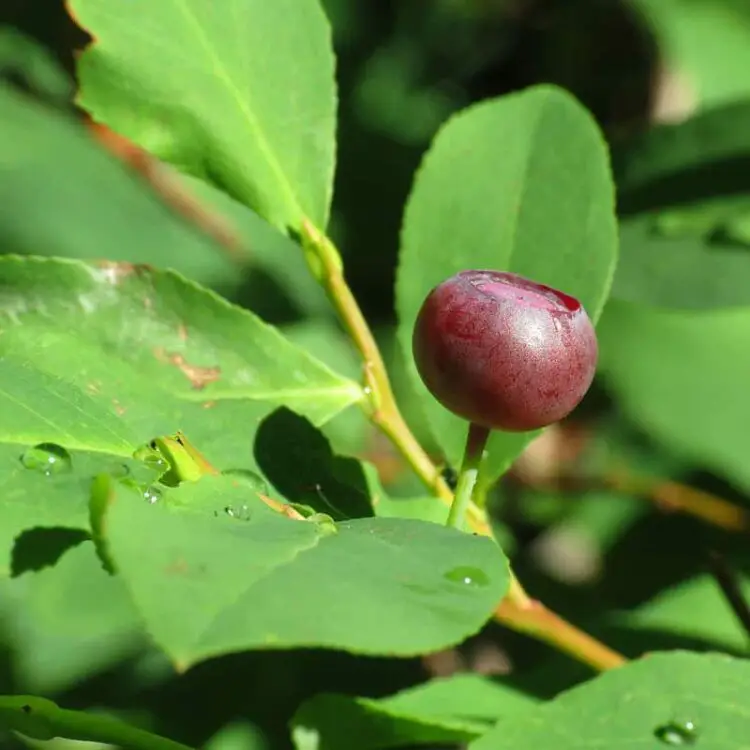
Huckleberries In Wyoming
Huckleberries are one of those rare treats. They’re sweet, and a little tart. The edible berries are high in vitamin C and antioxidants. They only really grow wild. Bears love to eat them, so there’s some fairly fierce competition for them. Huckleberries grow at higher elevations, so you have to head into the mountains to find them. With so much competition for these berries, and with them only growing for a few weeks each summer, it’s common for people to keep their known huckleberry locations to themselves.
That said, Wyoming is fortunate enough to have some great huckleberry spots. Grand Teton National Park is a popular hotspot. Many people try their luck around the lakes in the park during huckleberry season.
Huckleberries love acidic soils, so they tend to pop up after a wildfire has passed through.
Huckleberry plants are an evergreen shrub that can grow up to twelve feet tall. It likes to grow in moist areas, so near the lake is a great spot. You may also see it growing along roadsides. In the spring, the bushes show off pretty white flowers. These turn to ripe, dark blue berries in July.
These berries are enjoyed freshly picked on their own or can be made into ice cream, a pie, huckleberry butter, cake, or a glaze for a meat dish.

Wild Raspberries
Raspberries are a sweet and juicy fruit that grows in a variety of environments, including forests, wet meadows, and along riverbanks. In Wyoming, raspberries can be found growing in many different regions, including Grand Teton National Park.
To find wild raspberries in Wyoming, look for areas with plenty of sunlight and a good water source, such as near a stream or river. Raspberries are often found in patches, so keep an eye out for a cluster of bushes with ripe, red berries.
It’s easy for berry pickers to be overly confident when it comes to identifying wild raspberries. Most people in North America have grown up eating raspberries purchased at the grocery store, so we feel like we know what a raspberry looks like. However, it’s good to always be careful. Raspberries have quite a few lookalikes, like thimbleberries or cloudberries. And while those two examples are edible, you still always want to know what you’re eating. Even if you’ve eaten raspberries from a grocery store before, make sure to use a field guide and really practice identifying green leaves, taking a look at the stems, and really examining the berries.
When you know that you’re looking at a wild raspberry, you’ll want to pick them carefully. Raspberries are delicate and can be easily damaged, so use a gentle touch when plucking them from the bush. It’s also important to leave some berries behind for wildlife and to ensure that the plants will continue to produce fruit in the future.
Wild raspberries can be enjoyed fresh or used in a variety of recipes, including jams, jellies, and baked goods.
You can find wild raspberries in June, July, and August, but July is usually the peak month to look for them in Wyoming.
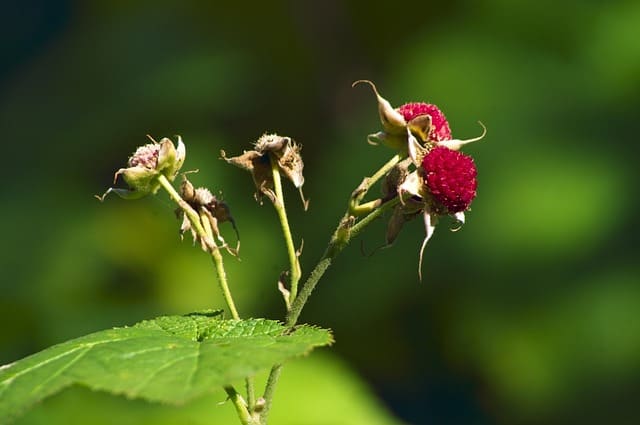
Thimbleberries
A member of the rose family, thimbleberries are bright red and remind many people of red raspberries. The edible berries can be very sweet, especially when they’ve grown in the full sun, but the ones you find in the shade may be more bland tasting.
While thimbleberries have a similar color and texture to red raspberries, they are flatter and less juicy. They have more of a crunch when you bite into them.
If you find a thimbleberry plant, you’re in luck. They tend to have many berries on one plant, so they’re great for foraging.
Thimbleberry season is in July, though you may still find some hanging around into August.
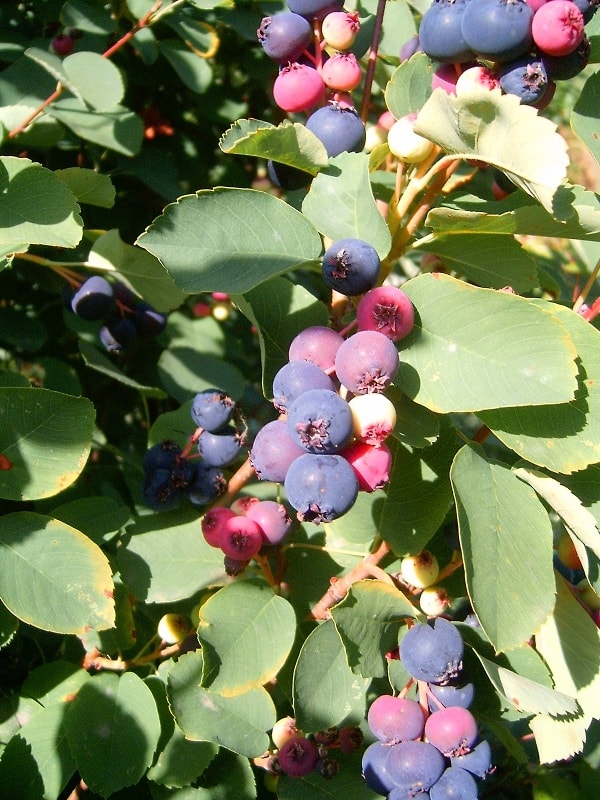
Serviceberries
The Saskatoon serviceberry is another member of the rose family growing wild in Wyoming. Serviceberries can be found in the northwestern part of the state. The berries are sweet, packed with antioxidants and vitamin C, and make a great treat right off the bush or cooked into pies or jams.
While these berries start off pink, they’re not ripe until they’re a dark blue or purple color. The stems are a deep brown that sometimes looks red. The simple green leaves grow on a large shrub.
Foragers looking for serviceberries in Wyoming will want to try their luck in July, though you may be able to find them as early as June or sticking around into August. If you find them in June, make sure they’ve ripened to their darker color.
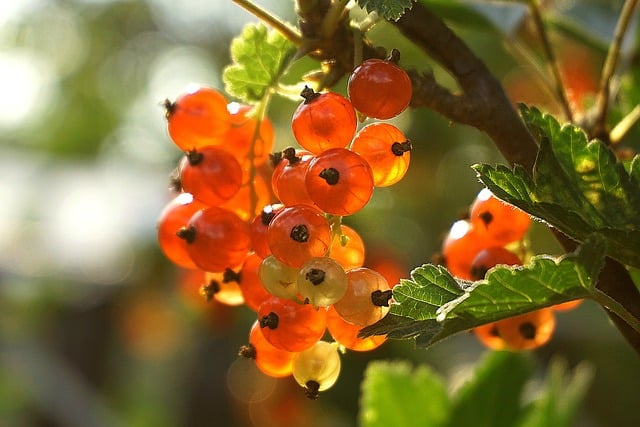

Currants
There are three kinds of currants growing in Wyoming. One of the most popular currants in Wyoming that tastes great is golden currants. In the spring, these currants have yellow trumpet-shaped flowers blooming along the trail sides or out in open sunny areas. They have a distinct and lovely smell that draws the attention of hikers. The nectar is so sweet that some people eat the golden flowers themselves. When they become edible fruits, the currants can be yellow, orange, purple, or red. They are shaped like globes and grow in clusters of ten.
Black currants are another popular currant. They are found in moist shady areas of big timber or along streams. They have white trumpet-shaped flowers that turn into sweet black berries.
Wax currants are not recommended to eat because their orange-red berries are very bitter.
Foragers will find ripe currants in Wyoming at the end of August or early September.
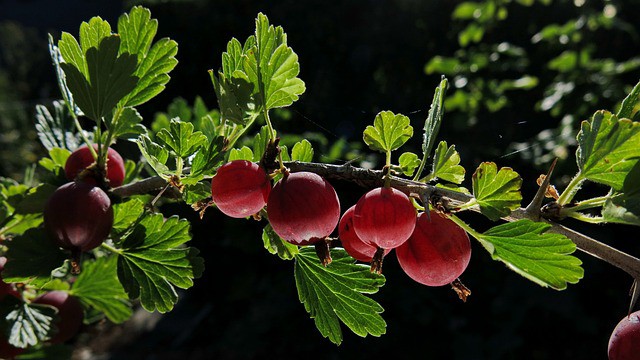
Gooseberries
Wyoming has whitestem gooseberry (Ribes inerme) and Rocky Mountain gooseberry (Ribes montigenum).
The whitestem gooseberry is in most of the mountains in the state, preferring to grow at high elevations. The shrub grows to be two to four feet tall. It has dark purple berries that are sometimes so dark they appear black. They are edible and can be enjoyed fresh off the shrub.
The Rocky Mountain gooseberry also grows at high elevations and is mostly found in the Rocky Mountains, as the name suggests. In the spring, the shrub sports pink flowers. The berries are a bright red. The berries ripen in August and September.

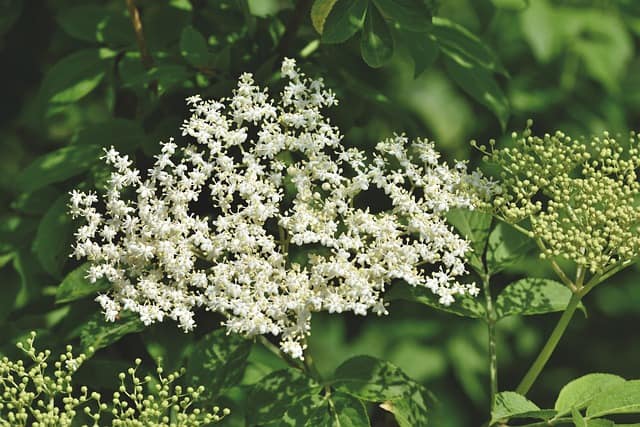
Elderberries In Wyoming
There are actually several different kinds of elderberries, and three of them can be found in Wyoming. For the most part, people will be seeing the red elderberries.
Elderberries need to be consumed with a fair amount of caution. Never, ever eat raw elderberries of any kind. The fresh berries, the leaves, and the stems are toxic to humans. You won’t see fresh elderberries being sold at a farmer’s market. Instead, you’ll see elderberry syrups, pies, and other forms that have seen the berries properly cooked before eating. You’ll need to strain the seeds during the cooking process.
Red elderberries grow on a bush approximately five feet tall. They grow in the mountains and often along waterfronts since they like moist soil. In the spring, the shrubs have white flowers. Many people eat elderflowers, though they are careful to remove the flowers from the stems, which are toxic.
Elderberries ripen in the late summer, in mid-August through mid-September.
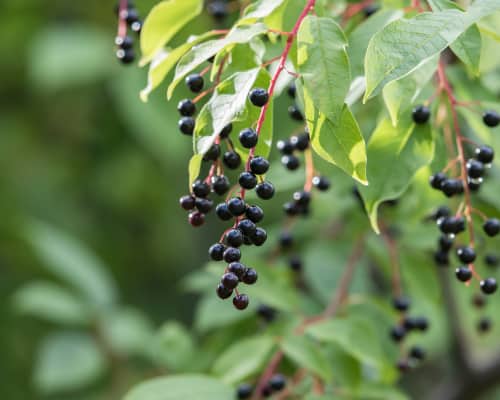
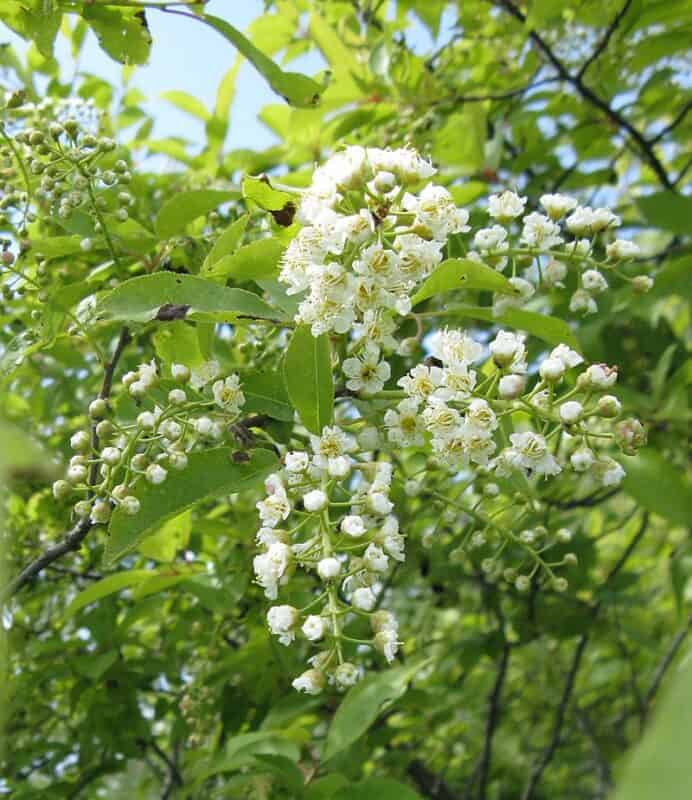
Chokecherry
Like Elderberries, chokecherry is edible, but it comes with rules. The thing to know about chokecherry is that it’s a stone fruit like plums, apricots, and common cherries. This means that you cannot eat the seed.
The inside of the seed is toxic to humans. If the seeds are eaten in large amounts and cracked open, their contents are converted into cyanide inside the human stomach. This is not safe for humans and can lead to serious side effects. In extreme cases, it can be fatal. The leaves are also poisonous. Note that chokecherries are also poisonous to pets, especially dogs.
With that warning out of the way, chokecherries are quite enjoyable, just like plums, apricots, and common cherries. The edible fruit comes as a bright red berry that ripens during the summer. Many people who hate the taste of chokecherries are actually eating them before they fully ripen. An unripe chokecherry may feel soft enough but will taste very bitter. When ripe, a chokecherry is a dark red or purple, so dark that they are nearly black. Even when ripe, they may be too tart for some people. Many people enjoy harvesting them, bringing them home, and making them into a sweetened jelly or wine.
Chokecherry season is in the late summer, typically late July or August.
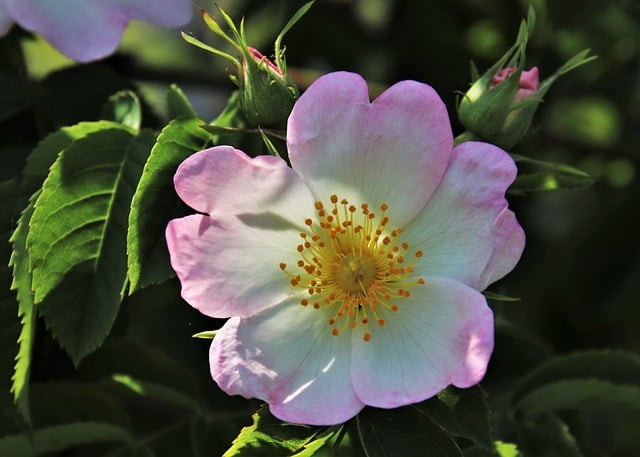

Rose Hips
There are four different species of wild roses that are found in Wyoming. The Wood’s rose, which is most commonly found, prickly rose, prairie rose, and the Nootka rose. The rose hips on each of these species are edible throughout the year. They were a good source of vitamin C for the native peoples and early settlers.
Flowers of the wild rose have five petals that are generally light to dark pink and have five sepals. The wild rose bushes grow in open wooded areas. The rose hips ripen in late summer and are orange to red in color. The rose hips remain on the plants and are available throughout the winter. They are sweet and yet sometimes tasteless but full of Vitamin C.
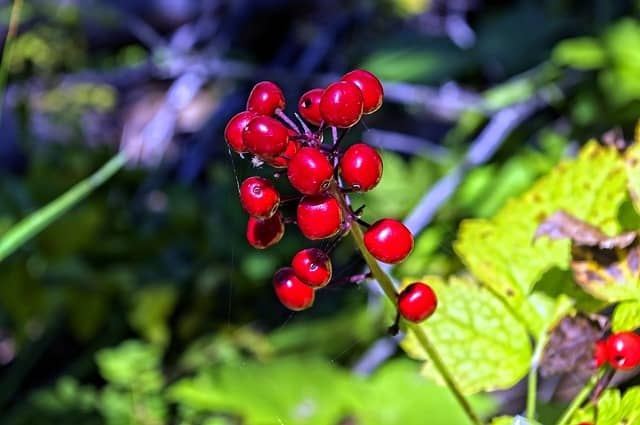
Are There Poisonous Berries In Wyoming?
Yes, there are poisonous berries in Wyoming that people should never eat.
Baneberry is a poisonous berry that can be found throughout the state of Wyoming. Western baneberry, also known as Actaea rubra, is a two to three-foot-tall shrub that sports bright red or white berries. In Wyoming, you’ll mostly see the red baneberry. The entire plant is toxic to human beings and can cause severe adverse effects. When a human eats a baneberry, it can almost immediately cause the heart rate to slow. This can lead to cardiac arrest.
If you are ever hiking and someone eats a baneberry, you should immediately contact poison control and seek medical attention.
Other poisonous plants in Wyoming include black twinberry honeysuckle, wild carrot, and death camas.
Foraging For Wild Berries In Wyoming
Wyoming is a state with a lot of different terrains, from the grass prairie to the stunning mountains. Foragers are fortunate enough to have BLM land, national parks, and public lands to explore. It’s definitely a great place to be if you want to learn how to identify native plants. Make sure you use trusted field guides and take the extra time to look at the stems, leaves, and wild berries themselves as you work to name the plants in Wyoming.
Recent Posts
The only venomous snakes in Washington State are Northern Pacific Rattlesnakes. The Northern Pacific Rattlesnake (Crotalus oreganus oreganus) is a sub-species of the Western Rattlesnake. Anyone...
Skunks are not classified as true hibernators. But they go into a state of torpor when the weather gets cold. Skunks are light sleep hibernators, along with opossums, bears, and raccoons. ...
